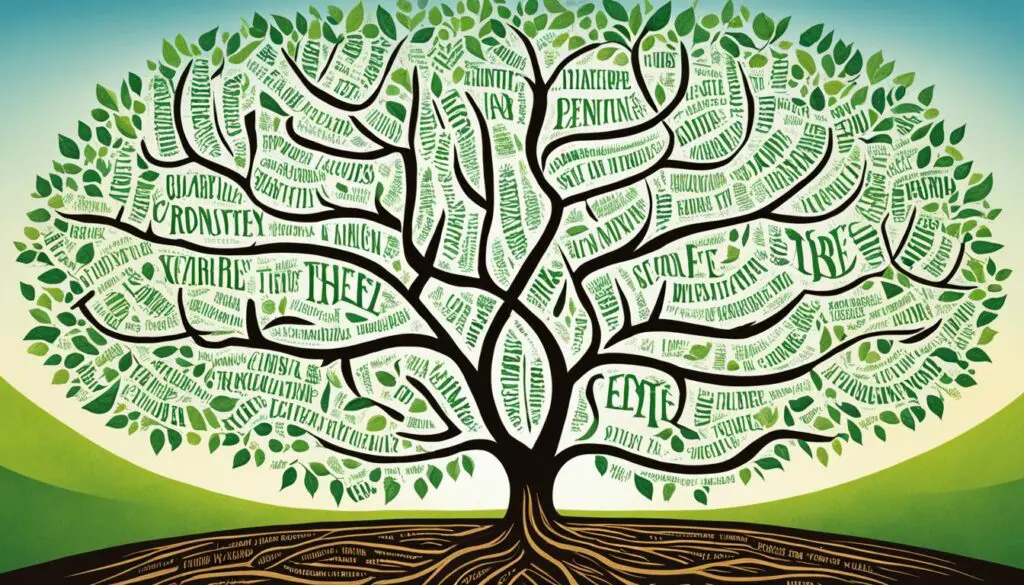Studying Scripture is key for Christians to grow their faith and relationship with God. But understanding the Bible’s deep concepts can be hard. Luckily, mind mapping is a great tool for this.
Mind mapping isn’t just for projects; it can also help in Bible study. This technique uses visuals to make complex information easy to grasp. By visually organizing Bible verses and topics, you see how key ideas connect.
To mind map a verse, first, pick one you want to understand better. Then, find the main ideas in that verse. You can use tables, lists, or circles to show how these ideas link together.
The best part is making connections in your mind map. Find other verses that tie in with what you’re studying. By doing this, you gain a richer insight into God’s Word.
Mind mapping isn’t just helpful for studying. It also boosts memory and research skills. Plus, it helps you feel closer to the Bible by digging deeper into its teachings.
Why not try mind mapping in your Bible study? It’s a great technique for beginners and experts alike. It can make your study of Scripture more meaningful and enjoyable.

Key Takeaways:
- Mind mapping is a powerful technique for visualizing complex information, which can also be applied to Bible study.
- By creating visual representations of Bible verses or topics, mind mapping helps us understand the relationships and connections between key concepts and themes.
- Select a verse or passage, identify the main concepts, and use visual elements like tables, lists, or interconnected circles to organize your thoughts.
- Draw connections within your mind map, look for related Scriptures, and reflect on what you’ve learned to deepen your understanding of God’s Word.
- Mind mapping boosts memory, research skills, and builds a stronger bond with Scripture.
How to Verse Map and Dig Deeper into Scripture
Verse mapping is an insightful way to study the Bible closely. It helps us see the true meaning behind verses. By looking at the verse’s parts, like its context and word meanings, we find hidden truths.
Start by picking a verse that really speaks to you. Write it down and look at it closely. Then, dive into the verse’s context. Look at the lines before and after. Think about the author and the scene. This gives you a better understanding of the verse’s bigger message.
Exploring the context this way helps us truly get what the verse means. It’s a great step towards deeper understanding.
After, check out different translations of the verse. Each version might show something new. Use a concordance to find other verses that link to your chosen one.
Make the verse map work for you. Highlight the key words. Underline phrases that come up more than once. Mark places you want to think about more. This makes the verse come alive and easier to understand.
Paraphrasing and Personal Reflection
Putting the verse in your own words is key. It lets the verse’s meaning hit home for you. Think about how you can live out its message. What is God calling you to do?
Verse mapping suits everyone. You can do it on your own or with others. It’s a great way to learn from the Holy Spirit and apply God’s teachings to your life.
Benefits of Verse Mapping
Mapping out verses has many pluses:
- Enhanced comprehension: It makes us really understand what Bible verses mean.
- Personal connection: Helps apply Scripture to daily life.
- Deeper insights: Lets us see profound truths in the Bible.
- Transformative impact: It helps God’s truth touch our hearts.
Spending time mapping out verses enhances Bible study. It deepens our bond with God and the Bible.

Bible Summary Maps: A Visual Summary of Scripture Topics
Studying the Bible offers many Christian tools to deepen understanding. Bible summary maps are among these. They visually summarize scripture topics for easier learning.
These maps are designed in a mind map layout, using keywords and colors. They help with memory and understanding topics at a glance. They are great before diving into depth.
Mind mapping is a strong method to organize Bible info. You can do this with tools like X-Mind, or by hand. These maps can always grow and change as you study.
Bible summary maps help see the big picture of the Bible’s structure and themes. They are a great way to learn from God’s Word. By using these maps, you can make stronger connections and find deeper meanings in the Bible.
Consider using Bible summary maps in your study plan. They change how you see and understand the Bible. They offer a new, visual way to explore deep truths in Scripture.
FAQ
What is mind mapping in the context of Scripture study?
Mind mapping helps you see complex information more clearly, including Bible study. It turns verses or topics into visual maps. This way, you understand the relationships and themes better.
How do I mind map Scripture?
Begin with a Bible verse or topic. Find the main points and lay them out visually. Include tables, lists, or circles to show connections. Then, find other Bible parts that relate.
Think about what it all means. This method boosts memory, research skills, and your relationship with Scripture.
What is verse mapping?
Verse mapping is examining a Bible verse’s parts closely. This includes its context, similar verses, and the meaning of words. It uncovers deeper truths and connects God’s message to your life.
How do I verse map?
Select a meaningful verse. Write it down and examine its surroundings. Ask questions about who wrote it and in what situation. Use different Bible versions to deepen your understanding.
Highlight important words, phrases, and study areas. Put the verse in your own words. Think about a step of faith God wants you to take. This method is great for personal or group study.
What are Bible summary maps?
These are one-page snapshots of a Bible topic in a mind map style. They use colors and keywords to link ideas and improve memory. Summary maps give an overview of a topic before you dive deep.
How can I create Bible summary maps?
Create these maps with mind mapping tools or manually. They help you understand Scripture’s big picture and themes. While X-Mind is a popular digital option, paper works just as well.
Update your maps as you learn more. They are great for constantly learning from the Bible.








